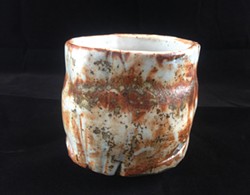[
{
"name": "Top Stories Video Pair",
"insertPoint": "7",
"component": "17087298",
"parentWrapperClass": "fdn-ads-inline-content-block",
"requiredCountToDisplay": "1"
}
]
Settling onto a wooden stool, artist Lauryn Axelrod relaxes her shoulders and breathes in slowly. Exhaling, she clears her mind and dips her fingers into a bowl of water. Beneath her, a small lump of clay whirrs quietly. She leans forward and presses into the spinning mass, feeling it push against her frame, letting the clay speak to her. Axelrod is intent upon her task without holding fast to a predetermined outcome. As a small bowl sprouts between her hands, this continual tug and pull between intention and acceptance gives focus and purpose to her thoughts. The rest of the world slips away.
In preparation for her upcoming show, Wabi-sabi: Tea Ceremony Ceramics, at the Fire Arts Center through January, Axelrod has repeated this contemplative process many times. Chanoyu, the traditional Japanese tea ceremony, utilizes a variety of ceramic vessels. Axelrod makes many of them, but the chawan, a small bowl for drinking tea, is at the core of her quest to craft pieces with spirit, meaning, defined use and, by tradition, a sense of perfect imprecision.
Chawan play an important role in the Japanese tea ceremony. Centuries old, this ritual is "a meditation on the appreciation of the beauty of the natural world, and the impermanence and imperfection of the human condition." It is a highly choreographed custom in which a host prepares powdered green tea for guests through an elaborately refined procedure. "It's not just tea," says Axelrod.
In many ways Axelrod's meditative approach at her potter's wheel mirrors the tea ceremony's commitment to focusing on the present moment. The ceremony is often held in a tea house in a small room adorned with only those items absolutely necessary. Stripped of visual clutter, the aesthetic of the space purposely sets participants' minds at ease so they can contemplate the ritual. "We're not thinking about what's for dinner, what happened yesterday, or what we are going to do tomorrow," says Axelrod. "We are present in this moment, with these people, these flowers, this scroll, this tea and this bowl."
The ceramic utensils of the tea ceremony are integral to the practice and chosen specifically, depending upon the host's style, the season, the guests and the type of ceremony, of which there are hundreds of iterations. Historically these vessels began as ornate Chinese porcelains but, over time, tea masters began to notice the subtle beauty of common peasant wares, appreciating how their flaws harmonized with the ceremony's emphasis on the uniqueness of the human experience.
This simple, subtle, imperfect aesthetic is known as wabi-sabi. It's "not pretentious and guilded," says Axelrod, but it's "not slovenly and not without craft" either. The "casual, almost thrown together look" has an elegance that is not easily described — a feeling that comes more from intuition than reason. A wabi-sabi potter seeks the natural imprecision found in nature. "What makes a forest beautiful," asks Axelrod, "with its fallen trees and its leaves all over the place? ... Things are not in 'order.' And yet, they are. In their imperfection is this sublime beauty."
If describing and appreciating a wabi-sabi pot sounds complex, creating one can be an even greater challenge. Chawan are created specifically for drinking tea, and therefore have certain technical demands like a smooth lip and an appropriate space inside for whisking the powdered matcha. But Axelrod also seeks an "ineffable feeling" in her tea bowls. A successful pot feels good in her cupped hands and "draws me into that sense of stillness," she says. "There's a sense of focus" to the piece.
"Canyon Wall" is one of Axelrod's featured chawan. It's a winter cup with thicker walls and a taller profile to hold the tea's heat longer. The coarse, recycled clay body peeks through in rusty patches from under the simple shino glaze, reinforcing a "dug from the ground" feeling. The piece tilts slightly, the lip wavers high and low. Although it's brand new, incised lines and crawling carbon-trap deposits give the piece an aged patina, as if it's slightly beaten up from decades of constant use. Chawan are not meant to sit on a shelf and be admired, Axelrod notes. "When things get used," she says, "they get worn."
The diversity of chawan in Axelrod's show highlight the infinite variations possible within this one humble vessel. "Two Bones," for example, is a wide bowl with relatively short, gestural walls. Throwing lines spiral up the piece, as if it's still spinning on her wheel. Wrapped in a viscous white glaze, two dark wax-resist streaks expose luscious iron-black clay, providing a focal point to the work. In the tea ceremony, once they drink the tea, participants admire the chawan; it is common for the cups to have a "front" to contemplate, and a "back" from which to drink.
The ritual of preparing tea becomes a meditative experience. Similarly, Axelrod's chawan aren't simply tea cups. Imbued with tradition and wabi-sabi aesthetic, they transcend that favorite-coffee-cup status to become something more. "We are vessels ourselves," she says. "The chawan is a metaphor for our own selves as vessels. In its imperfection, its beauty, its alive-ness, it contains not just tea."
Listings for Friday, Jan. 9 Arts! Arcata were not available at press time. For information on openings, exhibits and performances, please see arcatamainstreet.com.
The Journal is looking for more voices to add to the Art Beat column. Interested? Email [email protected].
more from the author
-
Porcelain Reborn
CR's group show honors the porcelain city
- Mar 5, 2015
-
The Prolific Hermit
Painter John Motian at Piante Gallery
- Feb 5, 2015
-
Home Grown
Redwood Art Association goes Off the Wall
- Jan 1, 2015
- More »
































